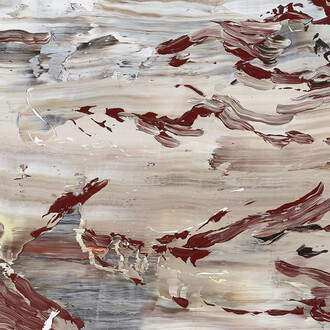Amanita and Fondazione Iris are delighted to welcome Rita Ackermann as the second artist to reside and exhibit at the foundation, a 17th century palazzo in Bassano in Teverina, a medieval village north of Rome that was one of Cy Twombly’s former studios and residences from 1975 until the end of his career. Amanita will present a solo exhibition of new work by Ackermann, including a suite of paintings and works on paper, a film, and a site-specific mural. The works in this exhibition are a culmination of Ackermann’s long-standing engagement with Twombly’s oeuvre and brush upon eternal themes of nature, divinity, mythology, and poetry. We would like to thank Hauser & Wirth for their support in the realization of this exhibition.
Fondazione Iris opened in 2023 after a two-year renovation project of the historic palazzo. Acquired in 1975, the building underwent a transformation in collaboration with Giorgio Franchetti under Cy Twombly’s guidance. Cy Twombly found solace in Bassano, immersing himself in the atavistic landscape of Tuscia, central Italy, the ancient homeland of the Etruscans. The thick tuff stone endemic to the area provided natural insulation, allowing Twombly to work in temperate conditions during the humid Italian summers. Fondazione Iris serves as a physical testament to the Twombly family’s commitment to preserving artistic heritage and nurturing creative endeavors. The foundation will welcome artists, scholars, and visitors, functioning as both an exhibition and performance space as well as a center for scholarly research. The foundation is also a custodian for Cy Twombly’s extensive library, providing a resource for scholars interested in engaging with Twombly’s collection of books and source materials.
Dr. Pamela Kort on Rita Ackermann’s Manna rain
“The nature that places the mask of the visible over the invisible, is only an appearance corrected by a transparence.”
(Victor Hugo)
Rain
It begins with a downpour, a birch switch of water, pelting a darkening landscape. It goes on unendingly until there comes an interim in which silence reigns. It is then that the presence of a different kind of cruelty slowly becomes manifest – a world bereft of grace and compassion. Entrapped there, a young girl can no longer distinguish between the tears of anguish streaming from her eyes, and the rivulets of rain dripping from her tattered dress. Crouched under a tree, she hugs her knees tightly, waiting for the squall’s retreat. But tempests are as indifferent to the constraints of linear time as the forms rained down upon a canvas by a painter. Patiently the girl waits while the ground goes muddy gray. Only with the sun’s first rays, does a miracle reveal itself to her as though through a stroke of erasure. Gone are the puddles of sludge. In their place this innocent now finds an abundant and glimmering dew, cloaking everything before her.
Freeze-Frame
In these new paintings and drawings there is a sense of absence. Parts of bodies – arms and legs – stand for something once whole, reduced to fragments. With every movement of the eye from left to right form is further wiped away. Ellipsis pervades. Go ‘in’ these paintings seem to say. Only then might you come ‘out’ with a shred of knowledge that might make sense of a debased world. Forget casting about for likenesses. If “God contains all forms” as Dionysus the Areopagite maintained, then truth lies in dissemblance. Arrest time to go beyond it. Consider the imperceptible gap between two images that have materialized on a transparent strip of film. It is in that liminal space that the invisible begins to dance, if only for a split-second.
Veil
The dust of chalk is akin to a shroud of paint. Both bestow an element of indeterminacy upon something supposedly fixed. Suddenly forms flicker; there is also a subtle sensation of circling. A body otherwise absent rolls down a hill, enwrapped in veil-like dress on her way to a distant place. The divine is near, something is passing by outside of time and space. It leaves an almost indiscernible trace. All we can perceive though is a certain mistiness, one that hints at release and the possibility of self-fulfillment as enduring freedom.
Rita Ackermann (b. 1968, Budapest, Hungary) currently lives and works in New York. Ackermann’s recent solo exhibitions include: Hidden, MASI Lugano, Switzerland (2023); Vertical vanish, Hauser and Wirth Downtown Los Angeles (2023); Mama ‘19, Hauser and Wirth New York, 22nd Street (2020); Brother sister, Hauser and Wirth Zurich, Switzerland (2019); Movements as monuments, La Triennale di Milano, Italy (2018); Turning air blue, Hauser and Wirth Somerset, England (2017); Kline rape, Hauser and Wirth New York, 22nd Street (2016); The aesthetic of disappearance, Malmö Konsthall, Malmo, Sweden (2016); Chalkboard paintings, Hauser and Wirth Zurich, Switzerland (2015); Meditation on violence-hair wash, Sammlung Friedrichshof, Burgenland, Austria and Sammlung Friedrichshof Stadtraum, Vienna, Austria (2014); Negative muscle, Hauser and Wirth New York, 69th Street (2013); Fire by days, Hauser and Wirth London, Piccadilly (2012); the Museum of Contemporary Art, Miami FL (2012); Bakos, Ludwig Museum, Budapest, Hungary (2011); and Rita Ackermann and Harmony Korine: ShadowFux, Swiss Institute, New York NY (2010).













